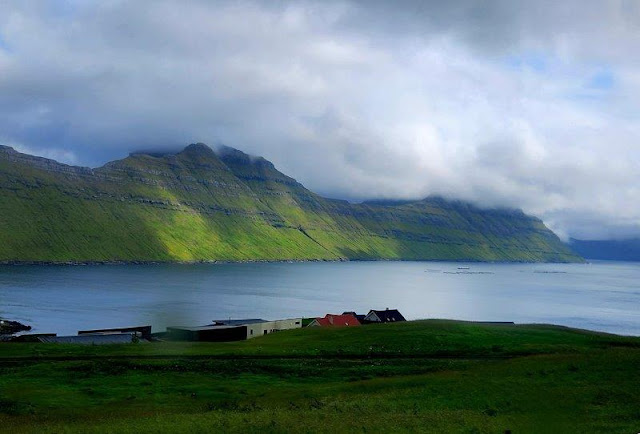Yesterday
was such an enjoyable day! We woke in the beautiful harbor of Isafjordur, one
of Iceland’s largest fishing centers. Fishermen come there annually and rent
the wooden houses in town to fish for salmon and trout. There are lots of
eateries and shops in Isafjordur which sits on a peninsula in a valley between
2 huge rock formations. I hate to think what the winters would be like here,
but the summers are mild enough to offer camping, hiking, skiing, golfing and
water sports (brrr....) These first photos are taken in the port.
 |
in the Isafjordur bay
|
 |
| reflections | |
 |
summertime in Isafjordur, Iceland
|
Our
American born guide spends her summers in Iceland (married to an Icelander) and
the rest of the year in the US. Our day started with a drive to Flateyri
village where we enjoyed a short guitar concert played and sung in the local language at the
church on main street, built in 1930.
 |
village church
|
 |
a peek inside
|
After our visit at the church, we walked
a short distance to the Old Book Store (1914) where books were originally sold
by the pound. The scales are still sitting in the store, along with dozens of
old ledgers still on display. Most of the books nowadays have a set price. From
there we went to a store where we were treated to coffee and local
pastries.
 |
main street, which we walked down the middle of
|
 |
some are of local birds
|
 |
local artistry on buildings
|
 |
this way to coffee
|
 |
The Old Bookstore (1914)
|
 |
wild poppies even grow in sidewalk cracks
|
 |
old Book Store ledgers
|
I’ll share a few things about the village of Flateyri.
*To
get to the village, we had to drive through a dark one-way tunnel cut through
the rock which is 15 kilometers (approx 9 miles). Cars going one direction have
the right of way, while those going opposite direction have to pull off in
designated areas. I tend to be a bit claustrophobic, so I had to read to keep
from feeling like I could breathe normally. Locals have an annual choral
performance inside the tunnel (acoustics are supposedly incredible).
*Population of Flateyri is 2,700.
*The
playschool (kindergarten?) is located next to an old folks home and they all
have lunch together, which is beneficial to all of them.
*Gas
price is $9 a gallon.
*Flateyri
has a 9 hole golf course but because of their fewer hours of daylight, they can
actually have a midnight golf tournament.
*
From mid-to late June, it remains daylight for 24 hours. In the winter, they
can get as few as 3-4 hours of daylight. Locals celebrate when they finally see
the sun after so many months of darkness.
*Lupine
(similar to our bluebonnets) was brought in from Alaska in the 80’s to help
stabilize the mountain sides. However, it has become invasive and grows
everywhere now. Many locals don’t like it because it has overtaken the wild
blueberries which were always harvested in the summer months.
*Locals
as well as guests use unfiltered water only.
*Sheep
are allowed to run free so drivers must carry sheep insurance in the event they
hit and kill one.
*An
avalanche in 1995 buried 17 homes and killed 20 people.
*The
first potato in Iceland was planted here.
I’m
sure she told us much more, but these are the ones I made note of. From
Flateyri, we drove about 45 minutes to Nupur to visit the Skrudur garden. It
was relatively small, but totally worth the visit! I’ve never seen such huge
poppies (they grow wild here and come in white, yellow, orange and red). There
was also beautiful lupine in purple, pink and white and all sorts of other
blooming plants.
 |
| Ronnie walking toward Skrudur garden gate |
 |
written in Icelandic
|
I was curious what this said so I used google translate to read "Madurinn sair og plantar. Gud gefur avoxtinn." Best I can tell, it just means "flower gate" which makes perfect sense. Below is another gate made from whale jaw bones that is inside the garden.
 |
whale jaw-bone gate
|
 |
purple or blue lupine
|
 |
5-6 inches in diameter
|
 |
white lupine
|
 |
walking trail outside garden
|
 |
| old wagons in the village |
After arriving back at the port, we walked a short distance
into town to look for some Christmas ornaments. Another ship was also in port,
so there were tons of tourists helping out the local economy. Again, we were
fortunate that it didn’t rain and the weather was pretty much just “jacket”
weather.
Words
can’t really describe how beautiful the countryside is in the summertime.
However, I’m quite sure I would not like to live there the other 9 months of
the year. You won’t be surprised to know that I took many photos. It’s hard to
pick just a few, so please indulge me. The ones below are some of my better "bus photo" photos. Not as sharp as I'd like, but hopefully you can get the idea of just how magnificent the countryside is.



















































